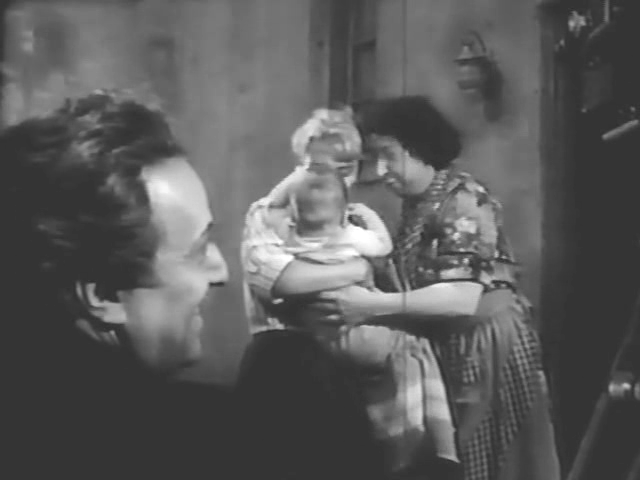|
Genres, Themes, Actors, and Directors:
- Do-Gooders
- Has-Beens
- Hugo Haas Films
- Marie Windsor Films
- Movie Directors
Response to Peary’s Review:
Peary begins his review of Paradise Alley by commenting on director Hugo Haas’s unique claim-to-fame as a “genuine auteur who starred in, directed, produced, and wrote a string of independently made melodramas” with “unorthodox themes” (such as multiple personalities, miscegenation, and death row), long before “indie films” became a burgeoning cottage industry. Indeed, Paradise Alley — Haas’s “crowning achievement and most personal film” — is a fitting swan song to his endearing oeuvre of unconventional films. It may be “hokey” and poorly acted (by former Miss Universe Carol Morris and others), but it’s also “heartfelt and harmless and offbeat”. Haas’s self-referential character — a humble, mysterious man who goes by the name “Mr. Agnus”, but is actually “Al von Stollberg”, a once world-famous director — wants nothing more than to help end both “the despair in [his poverty-stricken] neighborhood and the hostility that everyone feels for each other”. Indeed, Agnus could be seen as a “fairy godfather” of sorts in this modern-day fairytale, which has a most satisfying happy ending. In addition to the cast of mostly amateurs, watch for several famous faces — including Margaret Hamilton (typecast as a snippy bitch), Billy Gilbert (as her nemesis), Marie Windsor, and silent film comedian Chester Comedian (who shows off his impressive collection of movie memorabilia to Agnus).
Redeeming Qualities and Moments:
- Hugo Haas as “Mr. Agnus”

- A truly heartwarming story


Must See?
Yes, as Haas’s moving swan song.
Categories
Links:
|
4 thoughts on “Paradise Alley / Stars in the Back Yard (1962)”
There is much truth in the assessment here of ‘Paradise Alley’.
However, it is by no means a “crowning achievement”. And not a must. For a film to be must-see, it needs to be much more than merely interesting for some esoteric reason – or, in this case, admirable because it is the last statement of an early auteur in indie films. A must-see needs to have at least one kinetic quality about it that a film fanatic will benefit from. And ‘PA’ doesn’t have that.
It certainly has its heart in the right place. I’ll give it that.
And it gets better as it goes along. If it weren’t for the fact that I was watching as part of this ‘project’, I’d have easily thrown in the towel after 10 or 15 minutes. Painfully amateurish stuff on all counts. About halfway-through though, the film gains momentum – even though it’s never really all that good. From that point, at least, it’s somewhat watchable and even a little enjoyable, mostly as its overall theme crystallizes. The film does finally have a lovely message.
As noted, the acting is rather poor – but the film is bolstered by the known pros already mentioned (esp. Windsor – and Hamilton who, at one point, becomes almost coquettish!) – as well as Cyril Delevanti (as the grandfather) and William Schallert (who actually gives a surprisingly earnest performance).
I think this may be a classic example of how we differ (slightly) in our take on what makes a film “must see” or not — I tend to privilege films that are “interesting for some esoteric reason” because I like being familiar with the dusty corners of the film world. I certainly don’t always enjoy what I see when following this path, and much of it IS creaky, but I feel richer for the experience nonetheless; I don’t necessarily need to leave a film feeling like it’s enriched me or moved me in any particular way to feel that it’s worthy viewing (once). Indeed, there’s a part of my film fanatic personality that likes “having seen” films almost as much as I like “seeing films”…
Most film fanatics have their own ‘rules’ for must-see flicks. For me personally, a must-see film, much more often than not, does need to have at least one element that leaves me “enriched” when I leave it – or at least one that is likely to make me want to come back to it at a later date. That same element will make me want to tell others about the film or maybe watch it with them.
I know there have been films I have not liked (sometimes at all) that I nevertheless, for some reason, am glad I’ve seen. But, yeah, I’m a bit more rigid when calling something must-see.
One of the things I like about Peary is that he’s usually generous (without being soft-headed) in his reviews and doesn’t feel the need to show-off his critical credentials by being needlessly mean. However his comments that Haas was a “bad” director and this film is “harmless” I find a rare lapse from that standard.
Hugo Haas certainly made some bad films (like ‘Night of the Quarter Moon’ – although it was well-intentioned on race by the standards of its time). So did other directors who worked in the lower depths of Hollywood and don’t get called “bad filmmakers” (try watching some bad films of Edgar Ulmer or Joseph H. Lewis!).
I suspect Peary hadn’t seen some of Haas’s better films, especially ‘The Other Woman’ and ‘Born to be Loved’. He doesn’t list or mention them – but lists some of his lesser films. One thing that’s particularly clear linking ‘Paradise Alley’ to ‘The Other Woman’ is how reflexive Haas’s films could be – and how they were a commentary on the art of filmmaking (and especially his efforts to make art films with low-budget philistine producers). In that sense, Peary misses that Haas was a true modernist. Peary also misses Haas’s sympathy for the outsiders and the marginalised that is one of his consistent themes.